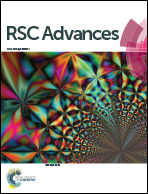One-step anion-assisted electrodeposition of ZnO nanofibrous networks as photoanodes for dye-sensitized solar cells†
Abstract
A highly efficient ZnO photoanode consisting of three-dimensional (3D) nanofibrous-like networks (NFs) for dye-sensitized solar cells (DSSCs) was synthesized using a one-step and seed-layer-free electrodeposition on an indium-tin-oxide (ITO) substrate at 75 °C in a solution containing Zn(NO3)2, KCl, NaCH3COO, and Na3C6H5O7. In this solution, KCl as the supporting electrolyte promotes the reduction of NO3− and the diffusion of Zn2+, whereas CH3COO− and C6H5O73− anions act as the capping agents to selectively inhibit ZnO growth along the c-axis. The photoelectrochemical results reveal that the DSSC based on ZnO NFs has the highest power conversion efficiency (3.78%) in comparison with those of DSSCs based on nanosheets (1.36%), nanorods (2.18%), and microplates (2.55%). This can be attributed to the large dye adsorption amount, efficient light scattering and direct electron transfer networks, which lead to a significant improvement in solar cell performance. Therefore, the ZnO NFs structure can be considered as a promising and efficient photoanode for DSSCs.


 Please wait while we load your content...
Please wait while we load your content...